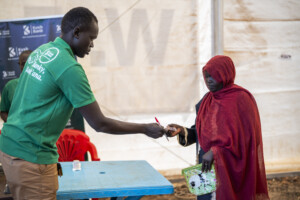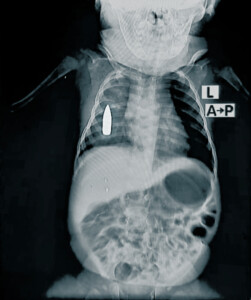Vector-borne diseases continue to spread in Sudan
Sudan has been facing various disease outbreaks in the past months, including cholera, dengue fever, Rift Valley fever (RVF), chikungunya, and malaria. The government and humanitarian partners actively responded to the outbreaks, UN OCHA reports. Most complaints reaching Radio Dabanga come from western and eastern Sudan.
 El Fasher Teaching Hospital (File photo)
El Fasher Teaching Hospital (File photo)
Sudan has been facing various disease outbreaks in the past months, including cholera, dengue fever, Rift Valley fever (RVF), chikungunya, and malaria. The government and humanitarian partners actively responded to the outbreaks, the UN Office for the Coordination of Humanitarian Affairs (OCHA) reports. Most complaints reaching Radio Dabanga come from the western and eastern parts of the country.
The increase of the outbreaks can be linked to the recent heavy rainfall in the country that have left large pools of stagnant water, which are breeding sites for various types of vectors such as mosquitoes and houseflies. The rainy season usually lasts from May/June to September/October.
Dengue fever, RVF, chikungunya, and malaria are vector-borne diseases, while cholera is waterborne.
Government authorities and humanitarian partners are actively responding to these outbreaks across the country, providing health assistance, vaccinations were appropriate, and vector control interventions, OCHA reported in its latest Sudan Situation Report on Thursday.
Responses
OCHA states that 1,197 dengue fever cases -including five deaths- were recorded in Red Sea state, Kassala, El Gedaref, North Kordofan, and North, West, and South Darfur, since the onset of the disease on August 8 until November 4. The majority of cases (1,111) are in Kassala.
The ministries of health in Kassala and North Darfur launched weekly response taskforce meetings, and developed state-level plans to mitigate the outbreak. Rapid response teams received refresher trainings. Case definition and management protocols have been distributed to all health facilities, and integrated vector-control and social mobilisation are being promoted.
RVF is rife in northern Sudan’s River Nile state, with 160 cases recorded. In total, 279 RVF cases – including nine deaths- were reported in Red Sea state, Kassala, El Gedaref, River Nile state, Khartoum, and White Nile state between September 28 until November 4.
Similar to the dengue response, the state Health Ministries activated taskforce meetings and developed response plans. The state Health Ministries, the World Health Organisation (WHO), and the Ministry of Animal Resources jointly investigated locations where the outbreak occurred. Health promotion activities have been carried out at household and community levels.
As for chikungunya, 63 cases -including three deaths- have been reported in South, West and East Darfur, and in Kassala since the onset of the disease on October 2. Response activities, mainly vector control, are ongoing.
“We daily receive between 70 and 200 patients infected with malaria; the majority being women, children and elderly. Yet we have only one doctor and one nurse serving the about 132,000 people living in the locality.” – Medical assistant in Sirba, West Darfur
Shortages
However, sources in West Darfur in the far west of the country and in eastern Sudan’s Kassala complain about a lack of medical staff, equipment, and medicines.
In Sirba in West Darfur, hundreds of people are suffering from malaria. Three patients died since the spread of the disease in October, medical assistant Dekka Abdallah reported to this station from Sirba Hospital.
“We daily receive between 70 and 200 patients infected with malaria; the majority being women, children and elderly,” he said. “Yet we have only one doctor and one nurse serving the about 132,000 people living in the locality.”
He further pointed to a shortage of life-saving medicines, medical devices and equipment.
On Thursday, hospitals in Kassala recorded 70 new cases of dengue fever, bringing the cumulative number of people infected since August to 1,367. Sixteen of them died of the disease.
Volunteers reported to Radio Dabanga that the 92 general practitioners and medical interns in the city’s hospitals are by far not enough to treat all the patients, in particular because of the growing number of dengue fever cases in the state.
In Red Sea state, health sources reported the spread of haemorrhagic fever and malaria in the areas of Arkawit, Saloum, and Arba’at.
Journalist Osman Hashim told Radio Dabanga that 15 haemorrhagic fever patients from these areas reached hospitals in Port Sudan.
Other challenges
OCHA also reports major gaps and challenges. The dengue response faces a lack of funding, shortages in tools and machines needed for spraying, the need to improve the capacity/work of national and state laboratories, and misdiagnosis of dengue fever cases due to its co-infection with malaria.
As for the RVF response, challenges consist of the limited number of partners involved in response activities and the need to scale up activities in the affected states. In addition, a more comprehensive plan needs to be developed between the government authorities and partners; more training in surveillance and case management is required; and social mobilisation and vector control activities need to be intensified.
If an outbreak occurs, limiting the movement of animals will reduce the spread of the disease. Saudi Arabia announced a ban on importing livestock from Sudan after the World Organisation for Animal Health reported documented cases of RVF.
The Health Ministry of East Darfur has activated a taskforce with the participation of all health partners to contain the spread of chikungunya. It is currently working on a comprehensive response plan with technical support from the WHO and the UN Children’s Agency (Unicef), the OCHA report concludes.
Yellow fever
The Sudan News Agency (SUNA) reported yesterday that the last round of yellow fever vaccinations in the country started in Khartoum this week: About 7.5 million people in the seven localities of Khartoum state, including displaced persons, refugees, and migrants, are targeted.
The national vaccination campaign against yellow fever was launched five years ago, and has been implemented in five stages. Earlier this year, more than 8.3 million people in El Gezira, Sennar, and Blue Nile state received a vaccination.
Darfur was stricken by a yellow fever epidemic in the end of 2012.
Radio Dabanga’s editorial independence means that we can continue to provide factual updates about political developments to Sudanese and international actors, educate people about how to avoid outbreaks of infectious diseases, and provide a window to the world for those in all corners of Sudan. Support Radio Dabanga for as little as €2.50, the equivalent of a cup of coffee.










 and then
and then